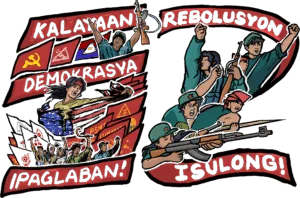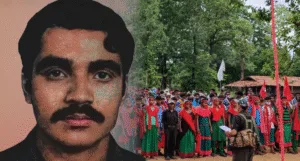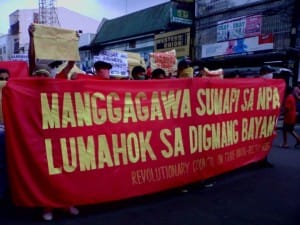Statement in Celebration of its 40th Anniversary
By Prof. JOSE MARIA SISON
Founding Chairman, Kabataang Makabayan
Founding Chairman, Communist Party of the Philippines
We are happy to celebrate the 40th Anniversary of the First Quarter Storm of 1970. This was the series of protest mass actions, which began on January 25, 1970 and continued up to March of 1970. It is chronicled by Jose F. Lacaba's Days of Disquiet and Nights of Rage and commented upon by Amado Guerrero's First Quarter Storm of 1970.
At the beginning, ten thousand students, urban poor youth, workers and peasants massed in front of Congress in order to express themselves against the anti-national and anti-democratic policies of the Marcos regime and against the excessive spending of public money to reelect Marcos as president.
Their peaceful demonstration was brutally attacked by the police with truncheon and gunfire upon the signal of Marcos himself after delivering his “state of the nation address”. The demonstrators fought back for several hours with bare fists, wooden handles of placards and stones.
Undaunted by state brutality, the Kabataang Makabayan (Patriotic Youth) and other organizations of the youth and working people formed the Movement for a Democratic Philippines (MDP). They conducted build up rallies in communities, schools and factories and then launched people's marches from different points of Metro Manila in order to converge on the focal points of reactionary power.
Tens of thousands of people joined and converged on the presidential palace on January 30, 1970. Some of the demonstrators seized a firetruck and rammed it through the gates of the palace and others made bonfires with their torches. Marcos became even more angered and openly threatened the declaration of martial in order to discourage further mass protests. But the proletarian revolutionaries and revolutionary core of the MDP stood fast on continuing the protest actions.
From week to week, the level of propaganda and agitation, organizational work and mass mobilization rose. Fifty thousand to 100,000 joined each of the marches and rallies, while other people lined the streets to cheer the marchers and give them food and water. The columns of marchers converged on plazas near the presidential palace or the US embassy.
The First Quarter Storm of 1970 caught the attention of the people on a national and international scale. It inspired the youth and working people in the provincial capitals and cities to rise up and carry out protest actions against US imperialism and the local reactionaries and demand national liberation and democracy.
The First Quarter Storm of 1970 was the highest point of the legal democratic mass movement for national liberation and democracy before the suspension of the writ of habeas corpus in 1971 and the declaration of martial law in 1972. It put forward the patriotic and progressive demands of the people against US imperialism and the local exploiting classes.
It resounded with the fighting slogans, “Makibaka, Huwag Matakot! Digmang bayan ang sagot sa martial law! (Fight, Don’t Be Afraid! People’s war is the answer to martial law!)”. It raised the fighting spirit of the broad masses of the people against the US-directed Marcos regime and against the repeated threats of the regime to declare martial law. It pushed the organized forces of the national democratic movement to accelerate their political and organizational work among the people.
The First Quarter Storm of 1970 was an unprecedented peak in the advance of the cultural revolution of the new democratic type, which called for a national, scientific and mass culture with the framework of the people's democratic revolution led by the working class. It was the product of a decade-long ideological and political work among the students and other youth and among the working people by the young proletarian revolutionaries.
It further generated and reinvigorated a new wave of study and mass work among the youth along the line of new democratic revolution. Schools for national democracy were organized and conducted at all offices of Kabataang Makabayan, on campuses, in the vicinity of factories, in communities and in all types of public places. Cultural works were created and presented to the youth and people in order to raise higher the level of their revolutionary consciousness and militance.
The First Quarter Storm of 1970 resulted in the political education of great numbers of people and their recruitment into the Kabataang Makabayan and other types of mass organizations. On the basis of the rapidly growing mass movement, hundreds and then thousands of mass activists were educated and recruited to become members of the Communist Party of the Philippines (CPP).
Consequent to the First Quarter Storm of 1970, the Kabataang Makabayan became a stronger engine for developing mass activists among the students and intelligentsia and among the young workers and peasants on a nationwide scale, for building revolutionary trade unions and for sending the educated youth and workers to the countryside for service in the New People's Army and in the rural communities.
The First Quarter Storm of 1970 was the key to the accelerated growth of legal mass organizations and such revolutionary forces as the CPP, NPA and the main components of what would become the National Democratic Front of the Philippines (NDFP). When the Marcos regime imposed martial law and fascist dictatorship on the country, the revolutionary forces and people were more determined than ever to wage protracted people's war along the national democratic line.
We should never forget the First Quarter Storm of 1970 as a major node in the development of the new democratic revolution in the Philippines. The achievements of the Philippine revolution since 1970 would not have been possible without this storm. We owe to it the emergence and development of so many cadres and mass activists and the growth of the revolutionary forces on a nationwide scale.
We must celebrate the great significance and continuing relevance of this historic event. We must renew our resolve to carry forward the Filipino people's democratic revolution against US imperialism and the local exploiting classes of big compradors and landlords.
We must undertake certain activities to raise the level of revolutionary consciousness and fighting capabilities in the next three months and further on.
We must step up the study movement and cultural work along the line of the new democratic revolution. We must enlighten and arouse the people by using all means of information, education and artistic expression. We must recruit more people into the patriotic and progressive mass organizations, especially those of the workers, peasants, women and youth. We must mobilize a far greater number of people to engage in various forms of struggle against the US-Arroyo regime and the entire semicolonial and semifeudal ruling system.
We face today the worst crisis of the world capitalist system since the 1930s because of the US-instigated policies of “neoliberal” globalization and imperialist aggression and terrorism. The broad masses of the people suffer conditions of exploitation and oppression far worse than four decades ago. These intolerable conditions drive the people and the revolutionary forces to fight more resolutely and militantly for their national and democratic rights and interests.






